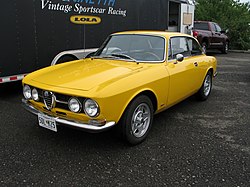U.S. tipo: 105.51. Motore: 00571.
 | |
| Production | 1967–1971 |
|---|---|
| Body style(s) | 2-door coupé |
| Engine(s) | 1.8L DOHC I4 |
| Wheelbase | 2,350 mm (92.5 in) |
| Length | 4,089 mm (161.0 in) |
| Width | 1,575 mm (62.0 in) |
| Height | 1,321 mm (52.0 in) |
| Curb weight | 1,038 kg (2,288 lb) |
The 1750 GTV appeared in 1967 along with the 1750 Berlina sedan and 1750 Spider. The same type of engine was used to power all three versions; this rationalisation was a first for Alfa Romeo.
The 1750 GTV replaced the Giulia Sprint GT Veloce and introduced many updates and modifications. Most significantly, the engine capacity was increased to 1779 cc displacement (80 mm bore × 88.5 mm stroke, 6.61l oil capacity, 9.58l radiator capacity). Peak power from the engine was increased to 122 PS (90 kW; 120 hp) at 5500 rpm. The stroke was lengthened from 82 to 88.5 mm over the 1600 engine, and a reduced rev limit from 7000 rpm to 6000 rpm. Maximum torque was increased to 186 N·m (137 lb·ft) at 3000 rpm. A higher ratio final drive was fitted (10/41 instead of 9/41) but the same gearbox ratios were retained. The result was that, on paper, the car had only slightly improved performance compared to the Giulia Sprint GT Veloce, but on the road it was much more flexible to drive and it was easier to maintain higher average speeds for fast touring. For the United States market, the 1779 cc engine was fitted with a fuel injection system made by Alfa Romeo subsidiary SPICA, to meet emission control laws that were coming into effect at the time. Carburettors were retained for other markets.
The chassis was also significantly modified. Tire size went to 165/14 from 155/15 and wheel size to 5 1/2J x 15 instead of 5J x 15, giving a wider section and slightly smaller rolling diameter. The suspension geometry was also revised, and an anti-roll bar was fitted to the rear suspension. ATE disk brakes were fitted from the outset, but with bigger front disks and calipers than the ones fitted to GT 1300 Juniors and late Giulia Sprint GT Veloces. The changes resulted in significant improvements to the handling and braking, which once again made it easier for the driver to maintain high average speeds for fast touring.
The 1750 GTV also departed significantly from the earlier cars externally. New nose styling eliminated the "stepped" hood of the Giulia Sprint GT, GTC, GTA and early GT 1300 Juniors and incorporated four headlamps. United States market 1750 GTV's also featured larger rear light clusters. Besides the chrome "1750" badge on the bootlid, there was also a round Alfa Romeo badge. Similar Quadrofoglio badges to those on the Giulia Sprint GT Veloce were fitted on C pillars, but the Quadrofoglio was coloured gold instead of green. The car also adopted the higher rear wheelarches first seen on the GT 1300 Junior.
The interior was also much modified over that of earlier cars. There was a new dashboard with large speedometer and tachometer instruments in twin binnacles closer to the driver's line of sight. The instruments were mounted at a more conventional angle, avoiding the reflections caused by the upward angled flat dash of earlier cars. Conversely, auxiliary instruments were moved to angled bezels in the centre console, further from the driver's line of sight than before. The new seats introduced adjustable headrests which merged with the top of the seat when fully down. The window winder levers, the door release levers and the quarterlight vent knobs were also restyled. The remote release for the boot (trunk) lid, located on the inside of the door opening on the B-post just under the door lock striker, was moved from the right hand side of the car to the left hand side. The location of this item was always independent of whether the car was left hand drive or right hand drive.
Early (Series 1) 1750 GTV's featured the same bumpers as the Giulia Sprint GT Veloce, with the front bumper modified to mount the indicator / sidelight units on the top of its corners.
The Series 2 1750 GTV of 1970 introduced other mechanical changes, including a dual circuit braking system (split front and rear, with separate servos). The brake and clutch pedals on left hand drive cars were also of an improved pendant design, instead of the earlier floor-hinged type. On right hand drive cars the floor-hinged pedals were retained, as there was no space for the pedal box behind the carburettors. Externally, the series 2 1750 GTV is identified by new, slimmer bumpers with front and rear overriders. The combined front indicator and sidelight units were now mounted to the front panel instead of the front bumper. The interior was slightly modified, with the seats retaining the same basic outline but following a simpler design.
44,269 1750 GTVs were made before their replacement came along.







